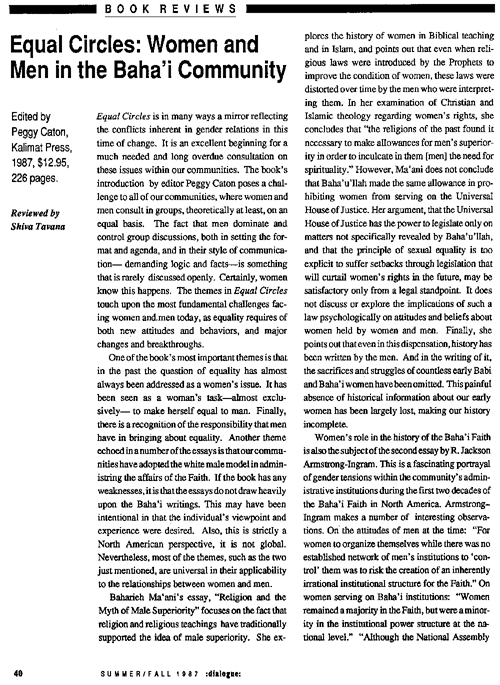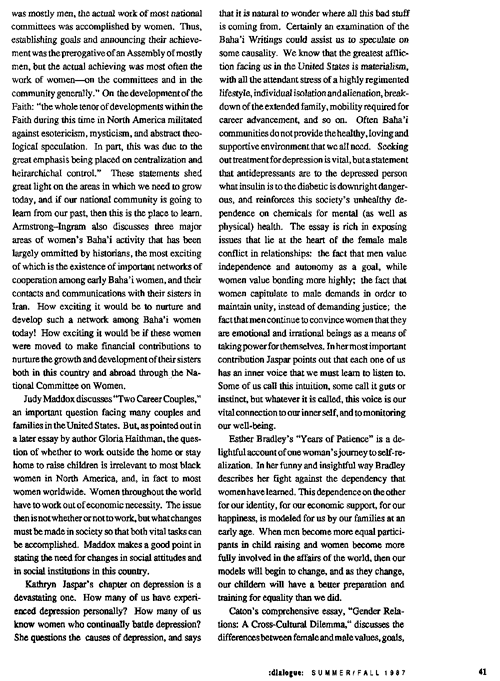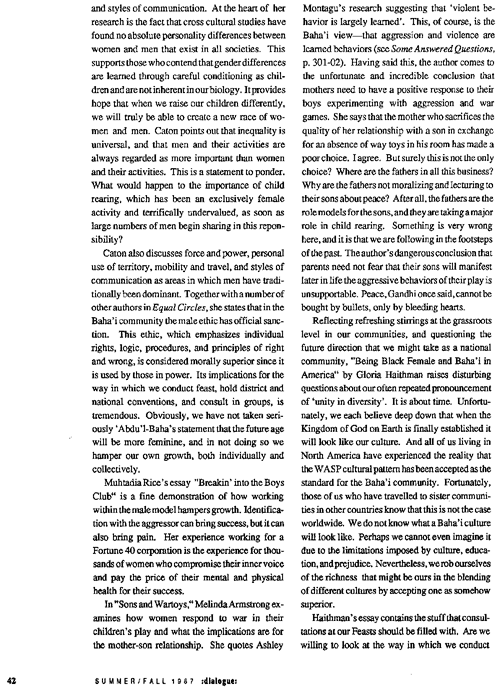
|
|
Notes: See also list of dialogue articles or image scans. |
Equal Circles, by Peggy Caton:
Review
by Shiva Tavana
published in dialogue, 2:1, pages 40-43Los Angeles: 1987
Author: Peggy Caton
Publisher: Los Angeles: Kalimat Press (1987)
Review by: Shiva Tavana
Review published in: dialogue 2:1 (1987)
Equal Circles is in many ways a mirror reflecting the conflicts inherent in gender relations in this time of change. It is an excellent beginning for a much needed and long overdue consultation on these issues within our communities. The book’s introduction by editor Peggy Caton poses a challenge to all of our communities, where women and men consult in groups, theoretically at least, on an equal basis. The fact that men dominate and control group discussion, both in setting the format and agenda, and in their style of communication—demanding logic and facts—is something that is rarely discussed openly. Certainly, women know this happens. The themes in Equal Circles touch upon the most fundamental challenges facing women and men today, as equality requires of both new attitudes and behaviors, and major changes and breakthroughs.
One of the book’s most important themes is that in the past the question of equality has almost always been addressed as a women’s issue. It has been seen as a women’s task—almost exclusively—to make herself equal to man. Finally, there is a recognition of the responsibility that men have in bringing about equality. Another theme echoed in a number of the essays is that our communities have adopted the white male model in administering the affairs of the Faith. If the book has any weaknesses, it is that the essays do not draw heavily upon the Bahá'í writings. This may have been intentional in that the individual’s viewpoint and experience were desired. Also, this is strictly a North American perspective, it is not global. Nevertheless, most of the themes, such as the two just mentioned, are universal in their applicability to the relationships between women and men.
Baharieh Ma‘ani’s essay, “Religion and the Myth of Male Superiority” focuses on the fact that religion and religious teachings have traditionally supported the idea of male superiority. She explores the history of women in Biblical teaching and in Islam, and points out that even when religious laws were introduced by the Prophets to improve the condition of women, these laws were distorted over time by the men who were interpreting them. In her examination of Christian and Islamic theology regarding women’s rights, she concludes that “the religions of the past found it necessary to make allowances for men’s superiority in order to inculcate in them [men] the need for spirituality.” However, Ma‘ani does not conclude that Bahá'u'lláh made the same allowance in prohibiting women from serving on the Universal House of Justice. Her judgment, that the Universal House of Justice has the power to legislate only on matters not specifically revealed by Bahá'u'lláh, and that the principle of sexual equality is too explicit to suffer setbacks through legislation that will curtail women’s rights in the future, may be satisfactory only from a legal standpoint. It does not discuss or explore the implications of such a law psychologically on attitudes and beliefs about women held by women and men. Finally, she points out that even in this dispensation, history has been written by the men. And in the writing of it, the sacrifices and struggles of countless early Bábí and Bahá'í women have been omitted. This painful absence of historical information about our early women has been largely lost, making our history incomplete.
Women’s role in the history of the Bahá'í Faith is also the subject of the second essay by R. Jackson Armstrong-Ingram. This is a fascinating portrayal of gender tensions within the community’s administrative institutions during the first two decades of the Bahá'í Faith in North America. Armstrong-Ingram makes a number of interesting observations. On the attitudes of men at the time: “For women to organize themselves while there was no established network of men’s institutions to ‘control’ them was to risk the creation of an inherently irrational institutional structure for the Faith.” On women serving on Bahá'í institutions: “Women remained a majority in the Faith, but were a minority in the institutional power structure at the national level.” “Although the National Assembly was mostly men, the actual work of most national committees was accomplished by women. Thus, establishing goals and announcing their achievement was the prerogative of an Assembly of mostly men, but the actual achieving was most often the work of women—on the committees and in the community generally.” On the development of the Faith: “the whole tenor of developments within the Faith during this time in North America militated against esotericism, mysticism, and abstract theological speculation. In part, this was due to the great emphasis being placed on centralization and hierarchical control.” These statements shed great light on the areas in which we need to grow today, and if our national community is going to learn from our past, then this is the place to learn. Armstrong-Ingram also discusses three major areas of women’s Bahá'í activity that has been largely omitted by historians, the most exciting of which is the existence of important networks of cooperation among early Bahá'í women, and their contacts and communications with their sisters in Iran. How exciting it would be to nurture and develop such a network among Bahá'í women today! How exciting it would be if these women were moved to make financial contributions to nurture the growth and development of their sisters both in this country and abroad through the National Committee on Women.
Judy Maddox discusses “Two Career Couples,” an important question facing many couples and families in the United States. But, as pointed out in a later essay by author Gloria Haithman, the question of whether to work outside the home or stay home to raise children is irrelevant to most black women in North America, and, in fact to most women worldwide. Women throughout the world have to work out of economic necessity. The issue then is not whether or not to work, but what changes must be made in society so that both vital tasks can be accomplished. Maddox makes a good point in stating the need for changes in social attitudes and in social institutions in this country.
Kathryn Jaspar’s chapter on depression is a devastating one. How many of us have experienced depression personally? How many of us know women who continually battle depression? She questions the causes of depression, and says that it is natural to wonder where all this bad stuff is coming from. Certainly an examination of the Bahá'í Writings could assist us to speculate on some causality. We know that the greatest affliction facing us in the United States is materialism, with all the attendant stress of a highly regimented lifestyle, individual isolation and alienation, breakdown of the extended family, mobility required for career advancement, and so on. Often Bahá'í communities do not provide the healthy, loving and supportive environment that we all need. Seeking out treatment for depression is vital, but a statement that antidepressants are to the depressed person what insulin is to the diabetic is downright dangerous, and reinforces this society’s unhealthy dependence on chemicals for mental (as well as physical) health. The essay is rich in exposing issues that lie at the heart of the female male conflict in relationships: the fact that men value independence and autonomy as a goal, while women value bonding more highly; the fact that women capitulate to male demands in order to maintain unity, instead of demanding justice; the fact that men continue to convince women that they are emotional and irrational beings as a means of taking power for themselves. In her most important contribution Jaspar points out that each one of us has an inner voice that we must learn to listen to. Some of us call this intuition, some call it guts or instinct, but whatever it is called, this voice is our vital connection to our inner self, and to monitoring our well-being.
Esther Bradley’s “Years of Patience” is a delightful account of one woman’s journey to self-realization. In her funny and insightful way Bradley describes her fight against the dependency that women have learned. This dependence on the other for our identity, for our economic support, for our happiness, is modeled for us by our families at an early age. When men become more equal participants in child raising and women become more fully involved in the affairs of the world, then our models will begin to change, and as they change, our children will have a better preparation and training for equality than we did.
Caton’s comprehensive essay, “Gender Relations: A Cross-Cultural Dilemma,” discusses the differences between female and male values, goals, and styles of communication. At the heart of her research is the fact that cross-cultural studies have found no absolute personality differences between women and men that exist in all societies. This supports those who contend that gender differences are learned through careful conditioning as children and are not inherent in our biology. It provides hope that when we raise our children differently, we will truly be able to create a new race of women and men. Caton points out that inequality is universal, and that men and their activities are always regarded as more important than women and their activities. This is a statement to ponder. What would happen to the importance of child rearing, which has been an exclusively female activity and terrifically undervalued, as soon as large numbers of men begin sharing in this responsibility?
Caton discuses force and power, personal use of territory, mobility and travel, and styles of communication as areas in which men have traditionally been dominant. Together with a number of other authors in Equal Circles, she states that in the Bahá'í community the male ethic has official sanction. This ethic, which emphasizes individual rights, logic, procedures, and principles of right and wrong, is considered morally superior since it is used by those in power. Its implications for the way in which we conduct feast, hold district and national conventions, and consult in groups, is tremendous. Obviously, we have not taken seriously ‘Abdu'l-Bahá’s statement that the future age will be more feminine, and in not doing so we hamper our own growth, both individually and collectively.
Muhtadia Rice’s essay “Breakin’ into the Boys Club” is a fine demonstration of how working within the male model hampers growth. Identification with the aggressor can bring success, but it can also bring pain. Her experience working for a Fortune 40 corporation is the experience for thousands of women who compromise their inner voice and pay the price of their mental and physical health for their success.
In “Sons and Wartoys,” Melinda Armstrong examines how women respond to war in their children’s play and what the implications are for the mother-son relationship. She quotes Ashley Montagu’s research suggesting that ‘violent behavior is largely learned.’ This, of course, is the Bahá'í view—that aggression and violence are learned behaviors (see Some Answered Questions, pp. 301-2). Having said this, the author comes to the unfortunate and incredible conclusion that mothers need to have a positive response to their boys experimenting with aggression and war games. She says that the mother who sacrifices the quality of her relationship with a son in exchange for an absence of war toys in his room has made a poor choice. I agree. But surely this is not the only choice? Where are the fathers in all this business? Why are the fathers not moralizing and lecturing to their sons about peace? After all, the fathers are the role models for the sons, and they are taking a major role in child rearing. Something is very wrong here, and it is that we are following in the footsteps of the past. The author’s dangerous conclusion that parents need not fear that their sons will manifest later in life the aggressive behaviors of their play is unsupportable. Peace, Gandhi once said, cannot be bought by bullets, only bleeding hearts.
Reflecting refreshing stirrings at the grassroots level in our communities, and questioning the future direction that we might take as a national community, “Being Black, Female, and Bahá'í in America” by Gloria Haithman raises disturbing questions about our often repeated pronouncement of ‘unity in diversity.’ It is about time. Unfortunately, we each believe deep down that when the Kingdom of God on Earth is finally established it will look like our culture. And all of us living in North America have experienced the reality that the WASP cultural pattern has been accepted as the standard for the Bahá'í community. Fortunately, those of us who have travelled to sister communities in other countries know that this is not the case worldwide. We do not know what a Bahá'í culture will look like. Perhaps we cannot even imagine it due to the limitations imposed by culture, education, and prejudice. Nevertheless, we rob ourselves of the richness that might be ours in the blending of different cultures by accepting one as somehow superior.
Haithman’s essay contains the stuff that consultations at our Feasts should be filled with. Are we willing to look at the way in which we conduct community affairs and say this the white male model and we would like to try some other way and see if it works better? Are we willing to be self-critical as a national community and honestly assess our strengths and weaknesses, and evaluate our progress? Haithman states that in our desire to paint a positive picture of the Bahá'í community we have, in fact, stopped working on eliminating racial prejudice. When will we begin to work on eliminating racism? I recall my astonishment at a recent community gathering when I shared my concern about racism in the community with a white Bahá'í man. No, he said, not in the Bahá'í community, as if we were somehow exempt. Yes, I said, I have seen it with my own eyes. Denying that the problem exists, while it may make us feel comfortable in the short run, will not make racism go away. It will not create unity in the long run. Discussing racial prejudice in open, frank and loving consultations in our communities can be a first step. Each community can then decide what other action steps they want to take over the long term. If we are going to build a new world order, then that order must be based on justice. We know that it cannot be based on anything else.
Moving is the only word to describe “Becoming a Man” by Sidney Morrison. “This essay should be translated into seventeen languages,” said one man I spoke to. “In a few pages he has captured the American dilemma.” Mr. Morrison, those of us who have not been privy to the requirements of manhood can only thank you and weep. Feminine values and emotions will not make men incompetent, but complete. “I knew my love for thee, therefore I created thee, have engraved upon thee my image.” For each man to get in touch with his feminine side is to get in touch with part of his own essence, placed there by his Creator.
At a recent informal gathering, our group began discussing gender issues. The few Bahá'í men that I have talked with feel threatened by ‘equality.’ To then, equality means sameness—that men may eventually look and act like women, and women may look and act like men. They stress differences between the sexes, argue that biology is destiny, and tell me that since men cannot breastfeed, the primary relationship and responsibility of the child is with the mother. All of them confirm the importance of child rearing but do not believe it is so important that they should get seriously involved. If they get seriously involved, they continue, who will make the money to support the family? They did not see the links between men sharing responsibility for child rearing, peace, and raising up a new race with spiritual values and ethics.
Discussing getting in touch with their feminine side was even more threatening. What feminine side, they wanted to know? Besides, wouldn’t that make them effeminate? We tried to meet in some middle ground. I stressed that I did not have any answers, only a lot of questions for us to consider together.
Needless to say these are sincere men, struggling to understand and to make a change they can feel comfortable with. But change and growth are usually painful processes. And ambiguity is uncomfortable. We need to have more talks like this. A lot more talks. Equal Circles had served as the springboard for our discussion. May it serve as the springboard for many many more.
 click for larger image |
 click for larger image |
 click for larger image |
 click for larger image |
|
|